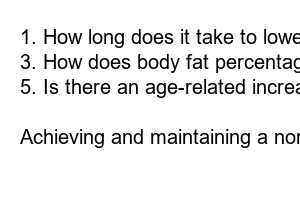체지방률 정상범위
Title: Understanding Normal Body Fat Percentage: A Guide to Optimal Health
Intro:
Maintaining a healthy body fat percentage is vital for overall well-being and achieving a fit physique. But what exactly is considered normal when it comes to body fat percentage? In this article, we will delve into the topic, offering valuable insights and practical tips to help you achieve and maintain a healthy range.
1. The Basics of Body Fat Percentage:
Body fat percentage refers to the proportion of fat in relation to your overall body weight. It is a more accurate indicator of health than weight alone since it allows a precise assessment of body composition. *Knowing your body fat percentage* helps you better understand how much fat you have in your body, allowing you to set realistic fitness goals.
2. The Ideal Body Fat Percentage:
The ideal body fat percentage varies based on factors such as age, gender, and activity level. *For men*, a healthy body fat percentage typically ranges between 6% and 24%, with 15% being the average. *Women* tend to have slightly higher percentages, with ranges between 16% and 30%, and an average around 20%. However, keep in mind that these numbers are not set in stone, and what matters most is maintaining a healthy range for your individual circumstances.
3. Importance of Body Fat Percentage:
Maintaining a normal body fat percentage offers numerous health benefits. *Optimal body fat levels* can decrease the risk of chronic diseases, improve cardiovascular health, boost metabolism, and enhance overall athletic performance. Moreover, it plays a crucial role in regulating hormone levels and supporting reproductive health in women.
4. Determining and Monitoring Body Fat Percentage:
There are several methods available to assess body fat percentage, including skinfold measurements, bioelectrical impedance analysis, dual-energy X-ray absorptiometry (DEXA), and hydrostatic weighing. While some methods require specialized equipment, you can also estimate your body fat percentage using online calculators or scales that utilize bioelectrical impedance technology. To monitor your progress accurately, it’s essential to use the same method consistently.
5. Strategies for Achieving and Maintaining Healthy Body Fat:
To achieve a healthy body fat percentage, combine a balanced diet with regular exercise. *Implement a well-rounded fitness routine* consisting of both cardio and strength training workouts. Engaging in resistance exercises stimulates muscle growth, which helps to increase metabolism and burn excess fat. Additionally, focusing on whole foods, reducing calorie intake, and avoiding sugary and processed foods can aid in achieving a desirable body fat percentage.
6. Understanding Body Fat Fluctuations:
Understanding that body fat percentage can fluctuate due to various factors is crucial. Hormonal changes, menstrual cycles, water retention, and even the time of the day can influence readings. Therefore, try to measure body fat consistently under similar conditions to obtain a more accurate representation.
FAQs:
1. How long does it take to lower body fat percentage?
2. Can you spot-reduce fat in specific areas?
3. How does body fat percentage differ from body mass index (BMI)?
4. Can body fat percentage be reduced solely through diet?
5. Is there an age-related increase in body fat percentage?
6. What strategies can help maintain a healthy body fat percentage in the long term?
Summary:
Achieving and maintaining a normal body fat percentage is an essential aspect of overall health. By understanding the basics, setting realistic goals, and adopting healthy lifestyle choices, you can work towards achieving a fit and well-balanced physique. Remember, consistency and patience are key on this journey – stay committed, and enjoy the rewards of a healthier and happier you.

